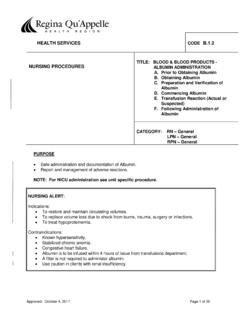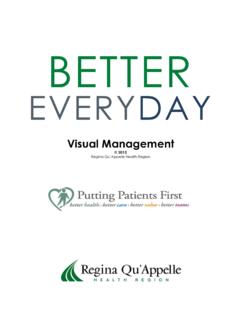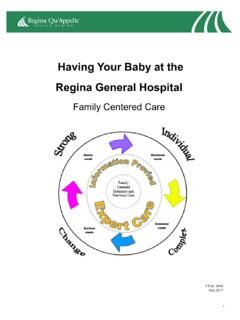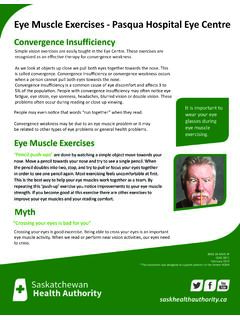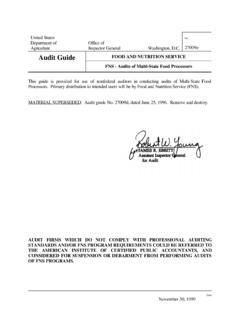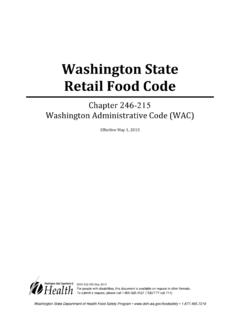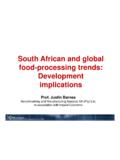Transcription of Home Food Processing - Saskatchewan Health …
1 home food Processing FACT SHEET I. INTRODUCTION Amendments to The food Safety Regulations allow home food processors to prepare low risk foods in their own home for direct sale to the public and to retail stores or wholesale establishments that do not prepare or process food for sale. The amendments: define a home food processor ; require the home food processor to ensure the water supply is safe; ensure home processed foods are labeled and prohibit the sale of products without a label; when necessary, require the home food processor to submit food samples to a laboratory for analysis to determine if it is low risk ; prohibit the sale of home processed food to public eating establishments ( restaurants), food manufacturing facilities and facilities that care for vulnerable populations ( hospitals, Health care facilities, licensed day care centres); and require home food processors to have food safety training.
2 A home food processor is a person who processes or otherwise prepares low risk food in his or her home or residence for direct sale to the public and/or to retail stores, for re-sale. This home food Processing Fact Sheet is intended to: inform the home processor about The food Safety Regulations; assist the home food processor in safe food production; and identify known low risk food items. home food Processing operations will not be subject to routine inspections by Health region public Health inspectors but Health region officials may need to visit these operations when investigating a complaint or potential food borne illness with a link to a home food Processing operation. II. LOW RISK FOODS Low risk foods are food items that have a water activity (aw) of or less or have a pH of or below and are not considered to be potentially hazardous.
3 Low risk foods tend to be high in sugar, salt or acid and/or low in water content, conditions which do not support the growth of bacteria, however recipes vary which can cause the food item to be potentially hazardous. In general, low risk foods do not require temperature control for safety and if handled properly do not cause foodborne illness. Refer to Appendix I for a list of known low risk foods. III. PERMITTED SALES A home food processor may sell low risk food directly to the consumer or to a retail or wholesale establishment that does not prepare or process food for sale. Refer to Appendix I for a list of known low risk foods. IV. PROHIBITED SALES No home processor shall sell low risk foods to: food facilities such as public eating establishments, restaurants, cafeterias, caterers and food manufacturing facilities, bakeries, cheese production plants and meat Processing plants; and facilities that care for vulnerable populations ( , ill persons, immune compromised, young and elderly) including: hospitals, Health centres, special care homes, personal care homes and licensed child care centres as specified in the regulations.
4 Options are available for home food processors who wish to expand their market, sell their product to food facilities. Processors are encouraged to consult with their local public Health inspector to discuss the options available to them. V. LABELLING OF food ITEMS The home food processor must label any low risk food he or she prepares or processes and sells to the public. The label will inform the consumer that the home prepared food item was prepared in a home kitchen that is not inspected by a government agency. The label is intended to assist the consumer in making an informed decision about the food they wish to purchase. Specifically, food labels must: be, at minimum, in 12-point font; contain the following statement, Made in a home Kitchen That is Not Inspected by a Government Agency ; and contain the name of the low risk food , the name of the home food processor , including any business name, the home food processor s address, and telephone number and the date on which the low risk food was prepared or produced.
5 Low risk food must not be sold or resold without the labels described above. Refer to Appendix II for a sample of a label. VI. LABORATORY ANALYSIS OF food ITEMS home food processors wishing to prepare or process food items not listed in Appendix I can choose to determine if the food is low risk by submitting the food to a recognized laboratory for analysis of the water activity and/or ph. If there are any concerns or questions about the food item, such as a public complaint or concern, the home food processor can then provide the results to their local Health region. In addition, the regulations authorize the Health region to request the home food processor to submit food samples, at their cost, to a recognized laboratory for analysis and to provide the Health region with a copy of the report. In most cases, the laboratory analysis will include pH and/or water activity tests at a cost from $35 to $150.
6 Should the laboratory report confirm the food item was not low risk , the home food processor may: discontinue Processing that particular food item; alter the recipe and have the food re-analyzed; or process the potentially hazardous food in an approved facility. In addition the regulations allow public Health officials to obtain food samples if there is reason to believe the food is contaminated, glass or metal fragments and a laboratory analysis is required to make the determination. In these cases the food processor will not incur the costs of the analysis. VII. SAFE food HANDLING The home food processor is responsible for ensuring that a person who has successfully completed a food safety course that is approved by the Health region is working in the premises of the home processor at all times when food is being prepared or processed for sale to the public.
7 food safety courses are offered regularly by Health regions and private businesses. There are also several approved on-line food safety courses. home food processors should contact their local Health region for details. The home food processor must ensure the food processed in their home kitchen for sale to the public is safe for human consumption. In order to meet this requirement, it is good practice when Processing low risk foods to: restrict certain groups, infants, small children, ill family members, and pets from entering the kitchen while food is being prepared or processed; keep the kitchen and food storage areas clean and in good repair; keep the kitchen equipment and utensils clean and in good repair; ensure: o food handlers practice hand washing prior to handling food and when hands become contaminated; o good quality ingredients are used, not spoiled, mouldy or contaminated; o all food contact surfaces, counters, cutting boards, utensils are washed, rinsed and sanitized before each use; o all food preparation and storage areas are free of insects and rodents.
8 O food handlers are not preparing or Processing food while ill, experiencing symptoms of vomiting, diarrhea, fever, cough, severe abdominal pain, infected wounds or lesions that are open or draining on or about the hands, wrists, or exposed portion of the arms; o food is packaged or covered to protect it from contamination while being stored, displayed or transported; and o food is packaged in containers that do not cause the food to become contaminated. VIII. WATER QUALITY The home food processor must ensure water used in home food Processing is safe for human consumption. Generally water from a public water supply is considered safe but private water supplies are to be tested regularly to ensure the water remains safe for human consumption. When using a private water supply water samples are to be submitted to an accredited laboratory ( Saskatchewan Disease Control Laboratory) for bacteriological analysis at the cost of the home food processor .
9 Sample containers may be obtained from your local Health region office. Private water supplies should be sampled and tested yearly or more frequently if there is reason to believe the water may have become contaminated. Anyone requiring clarification of the laboratory results are encouraged to contact their local public Health inspector. IX. ADDITIONAL INFORMATION Questions regarding home food Processing may be directed to the public Health inspector in your Health region. Note: This information was updated in August 2016. Visit the Ministry of Health website to view the most recent version of this document at: APPENDIX I LOW RISK FOODS The foods listed below are known to be low risk and may be processed in a home kitchen and sold directly to the consumer or to a retail or wholesale establishment that does not prepare or process food for sale. Baked goods/deserts without cream, custard, or meat fillings, cakes, squares, cookies, fruit pies, pastries Pickled vegetables made with salt and vinegar, cucumbers, peppers, beets, carrots, green tomatoes and onions (pH< ) Relish (pH< ) Honey, jam, jelly and applesauce Wine and herb vinegar Dry noodles that do not contain eggs Dried grains, seeds, herbs, and spices Cereals, granola, trail mixes Fudge, candy, cotton candy, syrup, toffee and chocolate Popcorn, popcorn balls Dried fruits Dry baking mixes Mustard Candied apples Dried or dehydrated vegetables Dried vegetarian-based soup mixes Vegetable and potato chips Ground chocolate Seasoning salt Please consult with your local public Health inspector if you wish to prepare or process any other food item that is not on the list but you believe it to be low risk.
10 APPENDIX II Example of a food Label in 12-point font August 1, 2016 Chocolate Chip Cookies Made by: Jane Doe 123 Main Street Small Town, SK S1A 1B2 (306)123-4567 Made on: August, 1, 2016 Made in a home Kitchen That is Not Inspected by a Government Agency
